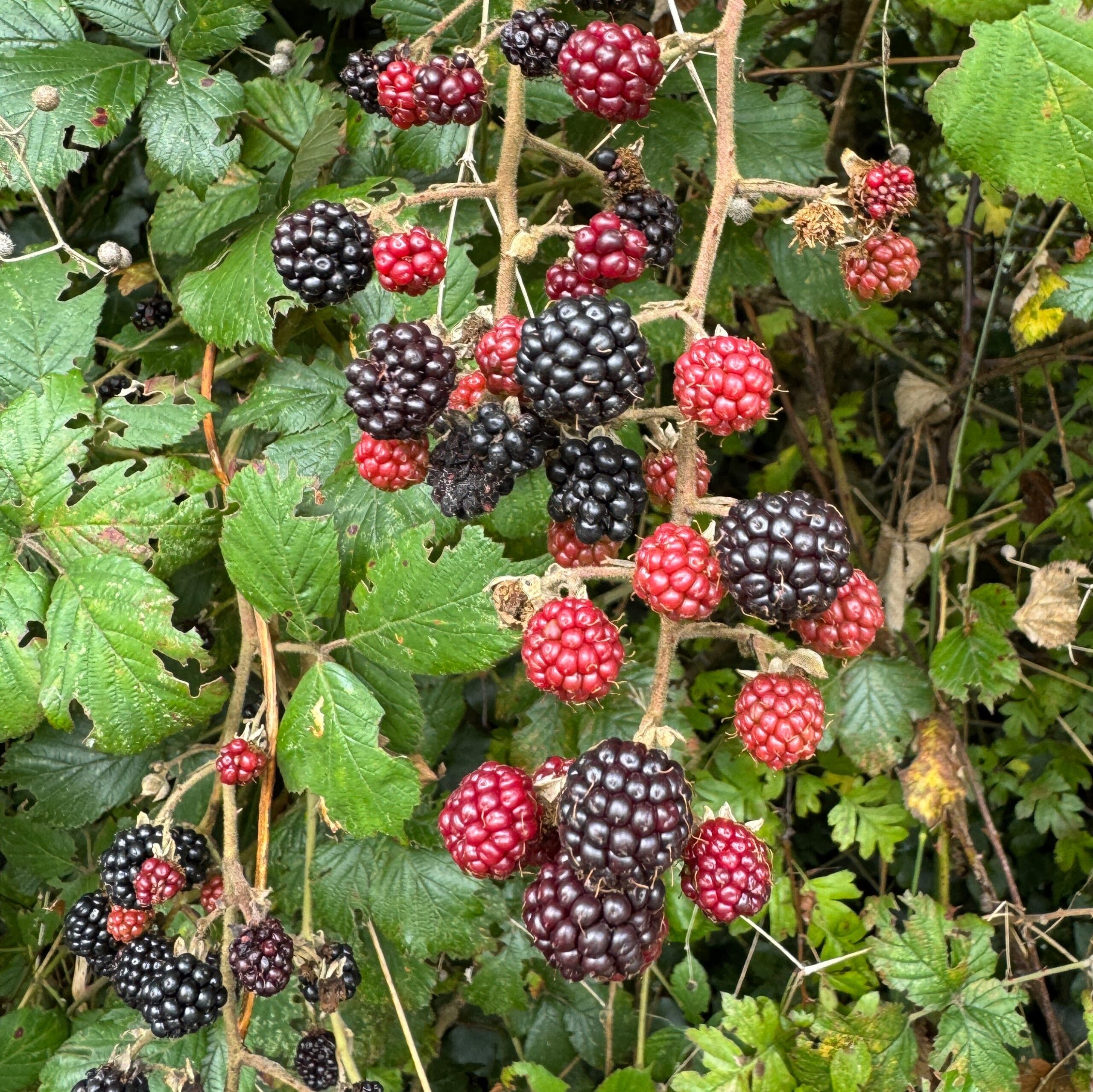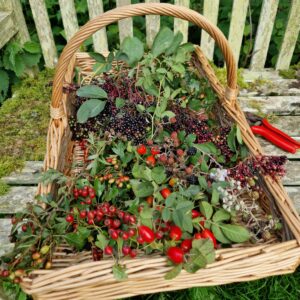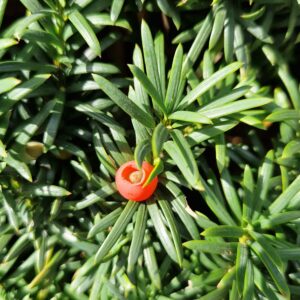BLACKBERRIES
Do you have memories of childhood blackberry picking?
Bramble, blackberry or Rubus fructicosus is probably the most well known and easily recognised of our native Irish edible wild plants. It is a wild food that anyone can pick with confidence, even if they know nothing at all about foraging. The clusters of deep purple-black berries ripen from late summer into autumn and can be found growing abundantly in hedgerows, country lanes, parks and many urban areas.
BLACKBERRIES Rubus fructicosus

“Late August, given heavy rain and sun
For a full week, the blackberries would ripen.
At first, just one, a glossy purple clot
Among others, red, green, hard as a knot.
You ate that first one and its flesh was sweet
Like thickened wine: summer’s blood was in it
Leaving stains upon the tongue and lust for
Picking.”
From “Blackberry Picking” by Seamus Heaney
Blackberry picking is an Irish tradition that is nostalgic for many people. Delicious eaten straight from the bramble, blackberries can also be used in tarts, crumbles, jams, syrups, cordials and much more.
It is best to pick blackberries on a dry, sunny day when they are less likely to have attracted any small insects. Make sure to avoid picking them from busy roads or areas that may be polluted or contaminated with herbicides or pesticides.
Rich in vitamin C, fibre and antioxidants, they are traditionally used to support the immune system, aid digestion, soothe sore throats and reduce inflammation.
BLACKBERRY CULINARY USES

Traditionally blackberries have been used to make jams, jellies, pies and crumbles. If you find the texture of the seeds irritating there are a few simple ways to remove them. You can pulse the berries in a blender and then push the pulp through a sieve, leaving you with a seedless puree. Another method is to heat them gently in a heavy based saucepan until they soften, then mash and strain. Use blackberry purée instead of lemons to make a delicious bramble curd. A purée is also useful for making blackberry mousse, fool, cheesecake, ice-cream or sorbet.
Blackberries combine particularly well with other seasonal fruits such as apples and elderberries and we generally associate them with autumn and winter comfort food. However they also go well with fruits that we more usually associate with summer, such as strawberries, peaches, melons and figs. Try them in a summer style fruit salad with melon. Toss the fruits in a combination of blackberry liqueur with a dash of balsamic vinegar, and then add some chopped fresh mint, lemon balm or lemon verbena.
Blackberries are also good in savoury dishes. Serve blackberry jelly with cheese or pate, make a sauce to accompany meat or game or try pickling them to add to a wide variety of dishes. I like to include them in a savoury salad. They work especially well with tomatoes, black olives, figs and feta cheese.
BLACKBERRY LIQUEUR RECIPE

INGREDIENTS
Blackberries
Sugar
Alcohol
METHOD
To make a blackberry liqueur, fill a preserving jar three-quarters full with your berries, top up with your sugar of choice (granulated sugar, brown sugar, coconut sugar, etc) and then pour in the alcohol to completely immerse the berries and sugar.

Use your preferred spirit. Vodka, gin and brandy work particularly well. Seal tightly and shake well to dissolve the sugar. Leave for at least four weeks, shaking every day for the first two weeks or whenever you think about it.

Strain the berries and bottle your liqueur. It makes a warming winter drink on its own or a lighter, refreshing drink when added to sparkling wine, sparkling water or soda water. It is also a great ingredient to use in cocktails.
The left over boozy berries can be used in cakes, jams, jellies or trifles.
BLACKBERRY MEDICINAL USES

Blackberries are rich in vitamin C and have antioxidant and anti-bacterial properties. Blackberry leaf tea is delicious and is a traditional remedy for colds and sore throats. A strong infusion can be used as a mouthwash for sore gums and mouth ulcers.
The underside of the older bramble leaves are covered in small thorns that easily embed themselves in the skin. Ironically, a traditional remedy to remove thorns and splinters is to apply a poultice made from blackberry leaves. I actually got a small thorn in my thumb while taking these photos, so I might put it to the test when I am finished this post!
LEARN MORE
If you would like to learn more about foraging and how to safely use wild plants for food, drinks and medicine, click on the links below to check out my in person and online workshops.
IMPORTANT WARNING
This information is for educational purposes only and is not intended to replace the advice of a qualified nutritionist or health practitioner.
Never use any wild plant if you are pregnant, have a serious illness or medical condition or are on any medication, without first consulting your medical team.
It is the responsibility of the reader to ensure that any wild plants are 100% correctly identified. If in doubt never use any wild plant for food or medicine.








Is it safe to use clevers I have some growing washed it and was going add to a smoothie
Hi Joyce,
Cleavers is generally safe for healthy individuals to use in small quantities. However in some circumstances it needs to be used with caution. If you have any underlying health issues, are on conventional medication, or are pregnant, it is always best to consult your medical practitioner before using any herbal remedies.